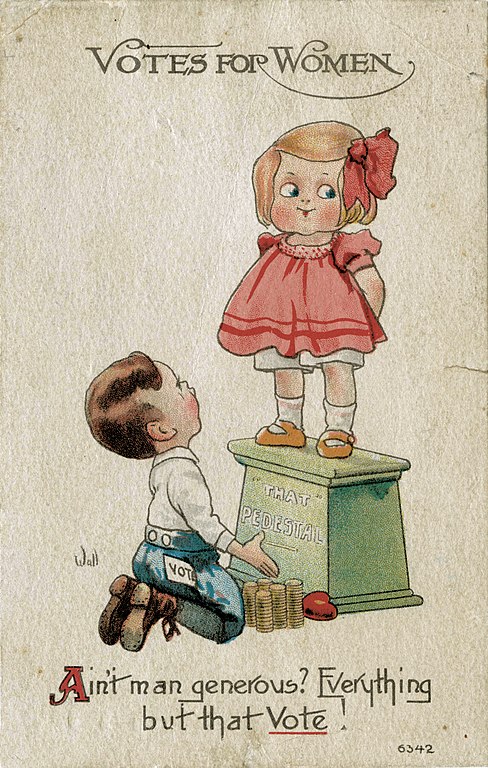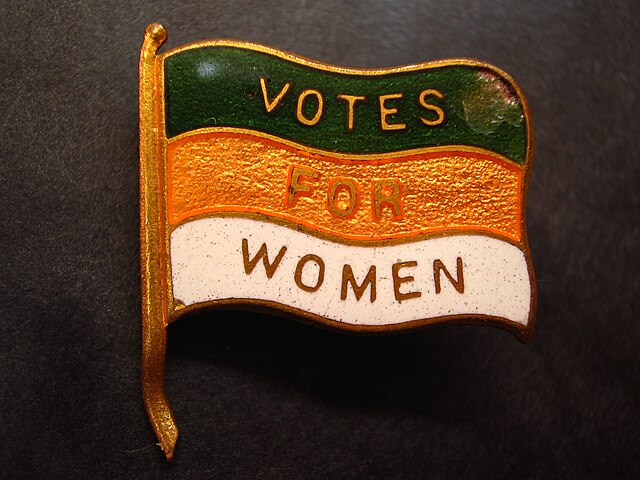
The Thammasat University Library has acquired a new book that should be useful for students of history, political science, sociology, gender studies, literature and related subjects.
100 Years of Women’s Suffrage: A University of Illinois Press Anthology is shelved in the General Stacks of the Pridi Banomyong Library, Tha Prachan campus.
The noun suffrage means the right to vote in political elections. Someone who is fighting for suffrage is fighting for voting rights. The word derives from a Latin term meaning assistance. If we vote for someone, we lend our support to, and assist, that person.
Writers of Thai English might note that although the words suffrage and suffer have letters in common, they have different word origins. Suffer, which means to experience pain, derives from a Latin term meaning to endure or put up with something.
2020 is the 100th anniversary of women’s right to vote in the United States of America. The Nineteenth Amendment to the United States Constitution prohibits states and the federal government from denying the right to vote to citizens of the United States on the basis of gender. The Nineteenth Amendment was officially adopted in August 1920 as the result of many years of campaigning for women’s suffrage at state and national levels.
Women who supported this social advance were called suffragists.
There is a difference between suffragists and a similar-sounding term, suffragettes.
As the British Library website explains,
Who were the suffragists and suffragettes, and what are the key differences between them?
In 1928 all British women over the age of 21 were granted the right to vote in political elections. Women’s suffrage societies – groups who campaigned for the right to vote – began to emerge in Britain in the mid-19th century. Those involved in the first wave of the campaign are known as suffragists. Suffragists believed in peaceful, constitutional campaign methods. In the early 20th century, after the suffragists failed to make significant progress, a new generation of activists emerged. These women became known as the suffragettes, and they were willing to take direct, militant action for the cause… From the perspective of some campaigners, the suffragists failed to achieve votes for women by peaceful, ‘respectable’ methods. Many disillusioned women began to advocate a more militant approach. These groups became known as the suffragettes, and they adopted the motto ‘Deeds not Words’.
In Manchester in 1903 Emmeline Pankhurst founded the Women’s Social and Political Union (WSPU) with her daughters Christabel and Sylvia. The organisation grew to include branches all over Britain and involved more working-class women. The WSPU adopted militant, direct action tactics. They chained themselves to railings, disrupted public meetings and damaged public property. In 1913, Emily Davison stepped out in front of the King’s horse at the Epsom Derby. Her purpose remains unclear, but she was hit and later died from her injuries.

Thailand and Women’s Suffrage
As many TU students know, women in Thailand were among the first women in Asia to be granted the right to vote in 1932.
However, an historical study by Professor Katherine Bowie of the University of Wisconsin, USA, published in Comparative Studies in Society and History in 2010, Women’s Suffrage in Thailand: A Southeast Asian Historiographical Challenge suggests that progress was more complex in the Kingdom and in other nations in the region:
Although much of the history of women’s suffrage has focused on the American and British struggles of the early twentieth century, a newer generation of interdisciplinary scholars is exploring its global trajectory. Fundamental to these cross-cultural comparisons is the establishment of an international timeline of women’s suffrage; its order at once shapes and is shaped by its historiography. According to the currently dominant chronology, “Female suffrage began with the 1893 legislation in New Zealand” (Ramirez, Soysal, and Shanahan 1997: 738; see also Grimshaw 1987 [1972]: xiv). In this timeline, “Australia was next to act, in 1902” (ibid.). Despite the geographical location of New Zealand and Australia in greater Southeast Asia, the narrative that accompanies this timeline portrays “first world” women as leading the struggle for suffrage and “third world” women as following their example.1 As Ramirez, Soysal, and Shanahan write, “A smaller early wave of suffrage extensions between 1900 and 1930 occurred mostly in European states. A second, more dramatic wave occurred after 1930” (ibid.). Similarly, Patricia Grimshaw writes, “It was principally in the English-speaking world, in the United States, in Britain and its colonial dependencies, and in the Scandinavian countries that sustained activity for women’s political enfranchisement occurred. Other countries eventually followed suit” (1987: xiv).
In this timeline, Thailand is listed as having granted female suffrage in 1932 (e.g., Daley and Nolan 1994: 350; Ramirez, Soysal, and Shanahan 1997: 743–44). However, although 1932 marks the first time Thai men and women could vote in elections for their newly created parliament, it does not mark the first time Thai women could vote. As I was stunned to discover in the course of conducting research on village voting laws, formal provisions for female suffrage in village elections in Thailand date to the Local Administration Act of 1897. In effect nationally, this hitherto overlooked act arguably establishes Thailand’s right to claim to be the second country in the world to enact female suffrage. More significantly, women in New Zealand and most other “first world” countries follow a pattern in which they gained voting rights only after an extended political struggle, and only after men. By contrast, Thailand is the first major country in the world in which women and men achieved the vote on an equal basis simultaneously and without any record of controversy… If in the Western countries the struggle for democratic suffrage was historically gendered, Thailand provides an alternative paradigm in which suffrage was never gendered. As the disparity between Thailand’s 1932 date on the international timeline and its actual establishment of female suffrage in 1897 reveals, the timeline has prioritized the dates of national elections over local-level electoral politics, and has thereby obscured this alternative worldview from study.
This essay, divided into four main parts, explores the historical context of Thailand’s ungendered suffrage and its implications for our understanding of the global history of women’s suffrage more broadly. In the first section I outline how the inclusion of female suffrage in the 1897 Act reveals Thailand’s independent indigenous historical trajectory in the face of colonial pressures. I then explore evidence regarding the presence of a Western suffrage movement in nineteenth-century Thailand, concluding that the possible familiarity of the Thai court with the suffrage controversies is insufficient to explain the country’s early adoption of universal suffrage. In the third part, I argue that universal suffrage in Thailand, rather than merely resulting from movements emanating in “the West,” instead emerged from the indigenous position of women embedded in a matrilineal kinship system. A final section considers the challenges the Thai case offers to both the criteria underlying the prevailing timeline and its attendant Eurocentric historiography. Arguing for the importance of an “eastern” village-based perspective to countermand the prevailing Western, urban-based perspective, I conclude by suggesting that external patrilineal colonizing forces may have thwarted rather than expanded the indigenous matrilineal political positions of women in greater Southeast Asia.

(All images courtesy of Wikimedia Commons)
